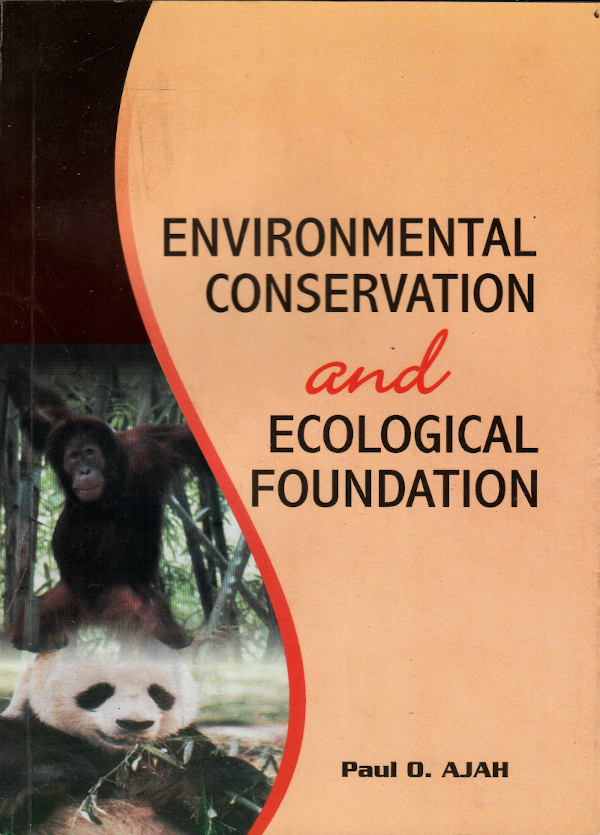Environmental Conservation and Ecological Foundation
$10.00
CONTENTS
List of endangered species
CHAPTER ONE: BIODIVERSITY AND CONSERVATION
– Intrduction
– What Biodiversity?
– Three basic ways man interferes with nature
– Why do we conserve?
– Aims of conversation
– How do we conserve our natural resources?
– Reasons for choosing a site for conservation
– Conservation agencies
Nigeria’s National Parks
– Vankari National Park
– Kainji Lake National Park
– Gashaka-Gumti National Park
– Cross River National Park
– Chad Basin National Park
– Old Oyo National Park
Habitat Preservation
Problems That Face Biological Conservation
– Consequences of species extinction
– Global approach to conservation strategy
CHAPTER TWO: WILDLIFE ECOLOGY AND CONSERVATION
– Ecology and Ecosystems Interdependence of life
– The deteriorating planet
Wildlife Resources And Their Management
– Why conserve wildlife
– Managing the habitat for wildlife
– Control of wild animals
Threatened species extinction
– Extinction rates
– Causes of threat to species
– Pictures of some endangered species
– Threats to flora and fauna
– Categories of threatened species
– Habitat Loss and Modification
CHAPTER THREE: FORESTRY AND DESERTIFICATION
– Introduction to forestry
– Why conserve the forest?
– Causes of Deforestation
– Ways of conserving the forest
Desertification
– Causes of land degradation
– Causes of desertification
– How to conserve the soil
Chapter FOUR: ECOLOGICAL FOUNDATION
– Ecology
– Population Growth
– Ecosystems
– Trophic relationship
– Energy Flow
– Producers
– Consumers
– Decomposers and Detritivores
– Whole ecosystem
Ecological pyramids
– Pyramids of numbers
– Pyramids of Biomass
– Energy Pyramids
Soil As An Ecosystem
– Mineral particles
– Pore space and air space
– Soil air
– Soil moisture
– Organic matter
– Soil pH
– Soil temperature
– Soil microflora
– Soil fauna
– Distribution of soil microorganisms
– Decomposition
– Food web in soil
– Nutrient cycling and energy flow
Biogeochemical Cycling
– The carbon cycle
– Nitrogen cycle
– Phosphorus cycle
– Sulphur cycle
The Diversity Of Plants And Animal Life
– Classification of life
– Species concept
Distribution Of Organisms And Associations
– Factors affecting the distribution of organisms
Biotic factors
– Competition
– Intraspecific competition
– Interspecific completion
– Competitive exclusion
– Grazing and food source
– Antibiosis
Abiotic factors
– Temperature
– Available oxygen
– Available carbon IV oxide
– Pressure
– Water potential
– Water movement
– Air movement
Primary Producers And Productivity
– Primary producers
– Fertility/Productivity
– Primary production
– Secondary producers
Aquatic Ecosystem
– Dissolved oxygen
– Decomposers
– Biochemical oxygen Demand
– Oxygen sag curve
Water Resources
– The hydrologic cycle
– Ground water
Water Resources Management
– Dams and Reservoirs
– Irrigation and Buildup of salts
Water And Waste Water Treatment
– Biological health hazards
– Urban water and sewage systems
– Sanitation and Sewage disposal
Water Treatment Fundamental
– Desalination
– Distillation techniques
– Electrolysis
Sewage Ireatmeni Fundamentals
– Primary
– Secondary
– Tertiary
– Disease causing microorganisms
– Microorganism’s usefulness
– Microbial interaction
– Bacteria biomass determination
CHAPTER FIVE: GENERAL POLLUTION
– Introduction to pollution
– Levels of metal concentrations in given systems
– How to prevent and control pollution
Land pollution
– Causes of soli fertility
Pollution of the Atmosphere
– Atmospheric pollution by heavy metals
– Atmospheric pollution by radiation
– Effects of air pollution
– Green House Effect
– Ozone layer depletion
– Human health
– Control of air pllution
Vegetation pollution
– Prevention of vegetation pollution
Pollution of Aquatic habitat
– Water pollution by heavy metals
Freshwater
a. Rivers
b. Lakes
Marine waters
Aquatic pollutants
– Types of Pollutants
– Heavy Metals and acide mine drainage
– Introduction
– Sources of exposure to toxic metals
– Harmful effects of heavy metals
– Treating heavy metal toxicity using Conventional chellators
– Natural heavy metal chellators
– Mercury
– Lead
– Arsenic
– Cadmium
– Chromium
– Thalium
– Copper
– Zinc
– Selenium
– Sulphur
Noise Polution
– Causes of noise pollution
– Control
CHAPTER SIX: OIL POLLUTION
– Causes of oil pollution
– Effects of oil pollution
– Oil spill prevention and managerial skills
– Safety objectives and control
Control of solid wastes
– Land farming
– Risk assessment and identification of hazards
Safety Drills
– Design of on-site emergency plans
Managerial duties
General control of oil wastes
CHAPTER SEVEN: WATER QUALITY CRITERIA
– Introduction
– Regulation of water quality by WHO & EU
– Guidelines for microbial parameter
– WHO guidelines for drinking water
– Guidelines for pesticides
– Guidelines for disinfectants
– Guidelines for industrial emissions
Description
PREFACE
Uppermost in the minds of the author is the fear that most plant and animal lives are becoming extinct. Giving the increasing rate of over-exploitation without following laid down regulations and conservation measures, more and more species will become extinct.
Secondly, but equally very crucial, is the incessant oil spills that have been occurring in the country in recent times which pollute both land and aquatic habitat and consequently lead to death of aquatic organisms and land degradation.
Thirdly, is the global concern emanating from the depletion of ozone layer in the stratosphere due to the increased release of chlorofluorocarbons (CFCs) resulting in easier penetration of the ultra violet (U.V) and infrared rays through the cloud to planet earth and consequently causing much heat. Considerable amount of Carbon IV oxide is released into the atmosphere from industries and these reduce the amount of heat that should have escaped to the atmosphere thus concentrating them back to earth, a phenomenon called “Green House Effect”. The heat is capable of rneltinc the polar ice, thus raising the level of the oceans and causing flooding of large cities. .We know that the biological resources are essential to human welfare, but the biological diversity (genetic, species and ecological diversities) of the planet earth is under great threat than ever before. It is confronted with problems from the local level (poaching, encroachment of protected areas) to the global level (deforestation, global climatic change).
Despite the efforts of biologists, ecologists, wildlife managers, and part planners, biological diversity is under great pressure the world over. More species than ever before are threatened with extinction, with hundreds. Perhaps thousands … disappearing yearly, a lot before they are ever described. Out of 9,000 birds worldwide, over 1,000 (11%) are at some risk of extinction and up to 290 birds species were threatened in 1978.
Keeping quiet to the incessant and rapid depletion of our environment and consequent species extinction will cause more harm, hence the origin of this book.
The book is aimed at creating early awareness in secondary school students of the need to conserve and preserve our environment for the present and future. It also presents Federal Environmental Protection Agency (FEPA), UNESCO, WHO, and FAO guidelines to healthy environment and safe drinking water standards in both Europe and America, which shall be of immense importance to undergraduates, scientists, oil industries, agro and allied industries, health organizations and environmental agencies.
The book is divided into seven chapters for easy referencing. Chapter one is the introduction to the subject matter-conservation. There is a detailed report of the available National Parks in Nigeria and their compositions. Chapter two describes wildlife ecology and conservation. Chapter three is on forestry and desertification. Chapter four is devoted to higher studies on ecological foundation and management approaches while chapter five deals with pollution of land, air, water, vegetation as well as noise pollution. Within this chapter are current information on most of the heavy metals and their deleterious effects both to humans, animals, birds, and the environment as a whole as well as their safe limits. A lot of emphasis is placed on heavy metal pollution and acid mine drainage effects. Chapter six concentrates on oil pollution with emphasis on oil spill prevention and control (management). The book ends with the seventh chapter giving specific details on Current water quality standards by WHO and EU for drinking water and industrial emissions.
Postgraduate students on Environmental studies and professionals as well as laboratory technologists will find this book a reference library for most issues on environment and health.

Prof. Paul Ajah
ABOUT THE AUTHOR
Professor Paul Ajah is a professor at the Faculty of Oceanography, University of Calabar, Calabar, Nigeria. He received His Bachelor of Science degree from Imo State University, Uturu, Nigeria in 1988 from the Department of Agriculture-Biology, Master of Science degree from University of Benin, Benin City in Zoology (Hydrobiology/Fish Biology) in 1989 and PhD from the University of Calabar in Fisheries and Aquaculture in 1995. The author was the pioneer Head of both the Department of Fisheries and Aquaculture, and the Department of Mariculture and Marine Fisheries Resources, University of Calabar. He has sought to widen his horizon by consulting with and writing EIA and PIA reports for several national and multinational environmental consultation outfits since 1992 to date including amongst others the following: Axxon-Mobil, Shell Petroleum, Agip oil, University of Calabar Consultancy Services (UNICALCONS), Prodec Fugro, Port Harcourt, Nigeria limited and Qualicon Nigeria Ltd. He has taught postgraduate students of Imo State University on environment management approaches and moderated several environmental consultation seminars in Ghana, such as “Waste and Waste management”, Friends of the Earth seminar etc. He was a Visiting Scholar to the Premier University of Ghana, Legon in 2001/ 2002. Prof. Paul Ajah loves the Lord of Heaven and earth, is an amiable young fellow and very much in love with nature. Prof. Paul Ajah is happily married to Mrs. Mabel Obioma P. Ajah and they Are blessed with two special children, Divine-Blessing and Daniel Ajah.
Questions and Answers
You are not logged in
